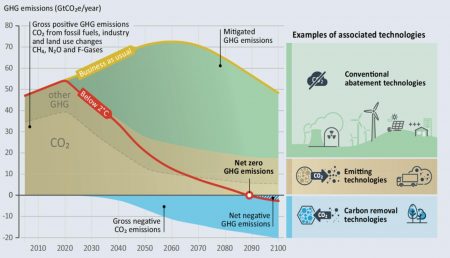February 27, 2019 – A report produced by the U.S. National Academy of Sciences, in Washington, DC, states,
“Humans started adding fossil CO2 to the atmosphere about 300 years ago and accelerated land use emissions by expanding croplands and pastures. The unintended consequence of these activities is a 120 ppm increase in atmospheric concentration of CO2, which is now changing our climate.”
Having said what seems obvious to most of us on the planet, with the exception of climate change deniers and the Trump administration, the report describes technologies that could be used to reverse the buildup of atmospheric CO2. Whether through sequestration using natural and technological solutions, the opportunity exists to develop a broad range of solutions which come under the name, negative emissions technologies (NETs). This group includes carbon capture and sequestration (CCS) and carbon capture utilization and storage (CCUS), although both are not exactly being used today to create a negative outcome. CCS and CCUS are add-ons to existing industrial facilities, used to trap CO2 as it is emitted, and then either compress or liquefy it and pipe it underground, or convert it where it can become permanently bonded within a product.
In the National Academy report it describes the current state of NETs. Some are close to deployment while others remain theoretical. In assessing the need for negative emissions technologies, the benchmark reference is Paris Climate Agreement of 2015. The reason for NETs is to work towards a global warming limit of less than 2 Celsius (3.6 Fahrenheit) degrees, and ideally 1.5 Celsius (2.4 Fahrenheit). The Trump administration has announced its intention to withdraw from the Paris agreement. Nevertheless, the report states its conclusions would be no different, with or without the federal government’s participation, because there is sufficient commitment from U.S. states, cities, corporations, NGOs, and other countries around the world to meet the targeted temperature limits. And NETs appear to be an important addition to a range of decarbonizing strategizing.
How should NETs contribute?
- NETs should be integrated into an overall climate change mitigation portfolio of strategies that includes industry-wide and personal carbon reductions by all.
- Four NETs are ready today for large-scale deployment including both natural and technological solutions. These include afforestation and reforestation, changes to overall forest management, soil CO2 retention in agricultural practices, and using biomass with CCS for energy generation.
- Current NETs can be scaled to capture and store substantial amounts of CO2.
- NETs can play a larger role in mitigating climate change if scaled up with a potential to remove 10 Gigatons of CO2 per year by 2050, and 20 Gigatons per year by 2100.
- The capacity of natural carbon sinks such as afforestation, reforestation, and soil CO2 retention is finite.
- Direct air capture and carbon mineralization technologies could add to the total capacity but currently are too costly.
- Blue carbon removal, and in particular, coastal projects could be added to improve CO2 uptakes.
- CO2 storage in geological formations could be critical for decarbonization of energy power plants using fossil fuels.
In all these conclusions there is an assumption that a price will be put on CO2 to justify development and implementation to make the economics of the technology sustainable. What that price should be varies depending on the technological solution.
The majority of current NETs if implemented have a cost recovery of $20 USD per ton of CO2. They are even viable at $100 per ton. But on some of these technologies there are obvious constraints. For example, there is only so much space for afforestation and reforestation because these compete with other forms of land use such as growing crops.
At 21st Century Tech Blog, we have described other negative emissions technologies including large-scale CO2 direct air capture. The National Academy report acknowledges direct-air’s potential but sees its major barrier to entry being the current high cost of CO2 recovery at around $600 per ton.
Another NET, carbon mineralization, is also constrained by many unknowns.
But if both of these can be developed to scale, and the economics can be made to work, they would play a significant part in climate change mitigation.
When would these two become viable? The price per ton captured has to drop as the technology scales up, while, at the same time, the price per ton of carbon has to escalate to a point where the two intersect.
What other constraints are currently holding back scaling NET solutions?
The report describes “significant scientific gaps remain for all NETs.” For example, carbon mineralization uptake in geological formations presents many unknowns.
How quickly will the mineralization occur?
Is the rate a variable based on the type of rock formation below?
Does all the carbon bind with the rock or can we leave pockets of CO2 underground that could later seep to the surface?
And there are potential negative feedbacks and unknowns when talking about CCS or CCUS technologies. The“long-term consequences” of sequestration technologies could have unintended results that directly impact climate change, sea level rise, and other physical alterations to the planet’s homeostasis.
In its conclusions, the National Academy report gives multiple reasons to pursue NETs including:
- initiatives by state, local governments, corporations, NGOs and other countries make it an attractive field for investigation in the effort to reduce carbon emissions.
- existing tax credits from $35 to $50 per ton for captured CO2, already on the books in many US jurisdictions, can be applied to NET research.
- the intellectual property and economic benefits to be accrued to U.S. companies and researchers makes this an important avenue for the country to pursue.
- and, of course, the end result of keeping global warming within 2.0 Celsius cannot be overstated.








